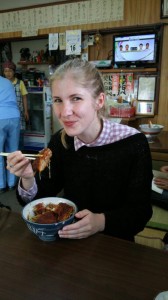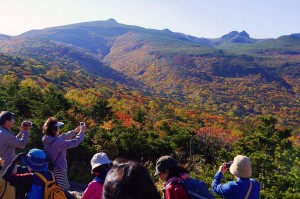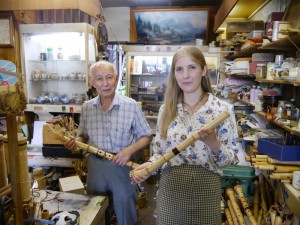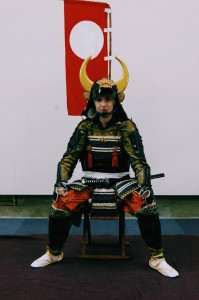
Zoë Vincent, now
Overseas Promotion Specialist at Fukushima Prefecture Tourism & Local Products Association
If someone had told me in August 2015, when I was just about to start my job as an ALT on the JET Programme, that in December 2016 I would be working as an Overseas Promotion Specialist at the Fukushima Prefecture Tourism and Local Products association, I definitely would not have believed them.
I began working as an ALT in Unzen City, Nagasaki Prefecture one month after graduating university. During my year abroad, spent studying in Tokyo, I did a short homestay in a very rural town in Yamagata Prefecture. A combination of this experience, my drive to improve my Japanese, and my long-term goal of studying at PhD level about the effect of 3.11 on local communities, I decided to apply for the JET Programme, hoping to get the chance to live in a rural area that I wouldn’t choose to go to as a tourist.
After one year of teaching at Elementary and Junior High Schools, I started my new position this August. I am the first person to hold my role, and my responsibilities include travelling around and learning about Fukushima Prefecture, sharing information about my experiences across a range of social media platforms, and conducting presentations in Japanese and English. There are challenges to working in a Japanese office, but the JET Programme has increased my resilience, flexibility and understanding of Japanese working culture.
Unlike many areas of Japan, most people have heard of Fukushima, albeit not for the right reasons. The nuclear accident of 2011 resulted not only in the displacement of countless communities, but also led to widespread misunderstanding, prejudice, and the circulation of harmful, fake information about the region’s safety. My role was introduced in order to work towards instigating better understanding about the side of Fukushima Prefecture that unfortunately doesn’t tend to grab the attention of the international mass media.
For example, Fukushima has the wealth of stunning scenery to be enjoyed in any season, which often serve as backdrops for temples, shrines, castles, and even olde-worlde streets of shops and factories preserved in the style of hundreds of years ago. Fukushima is also Japan’s second biggest peach producer (even post 2011!), and its climate provides the perfect conditions for growing a large range of produce. Visitors can embrace Japan’s public bathing culture and dip in one of Fukushima’s over 130 onsen hot springs (or opt for a room with a private onsen, to avoid public nudity)! They can also take a step away from everything traditionally Japanese and enjoy the ski slopes of Fukushima, which are yet to be discovered by hordes of holidaymakers!
I learned about my job at this year’s JET Leavers Career Fair in Tokyo. When I looked at the list of attending companies, it immediately stood out and I knew I had to apply.
One evening during my year abroad, at Waseda University, I clearly remember my friend bringing a bottle of sake to a party that she had bought in Fukushima. Due to seeing the word ‘Fukushima’ on the bottle, many of my friends avoided drinking it, voicing worries about its safety. Their reactions made me feel incredibly sad. Consequently I studied about the effect of 3.11 on farmers in Fukushima whilst I was researching for my dissertation. However, after graduating university I was aware that I still didn’t know very much, and that the stigma against Fukushima was still strong.
My current role has given me the chance to learn a great deal about the reality of living in Fukushima Prefecture – its safety and resilience – and to hear the proactive voices of the local people, as well as to learn about all of the wonderful achievements fulfilled here that are not given a voice in the international media.
I have visited amazing onsen, tried local delicacies, seen mountains covered in breathtaking autumn leaves, explored temples nearly 1000 years old, danced in local festivals, dressed as a samurai, eaten freshly picked white peaches, been taught how to play the shamisen, watched old ladies spinning cotton in a factory with hundreds of years of history, amongst many, many other experiences. In only four months, I can say with confidence that I love this place, and that I’m so happy, and lucky, to be here.
However, there is a long way to go before the international image of Fukushima changes, and the path to reaching this goal isn’t a straight one. By sharing current English-language information about the prefecture and its people through social media, and by working together with those involved in the tourism industry here, I am making a start. But this task is bigger than just what I, as one person, can achieve. I hope that I can be part of this important process, along with those who wish to join me!
Zoë blogs about her work and role at www.rediscoverfukushima.com
More information on the JET Programme can be seen HERE.




